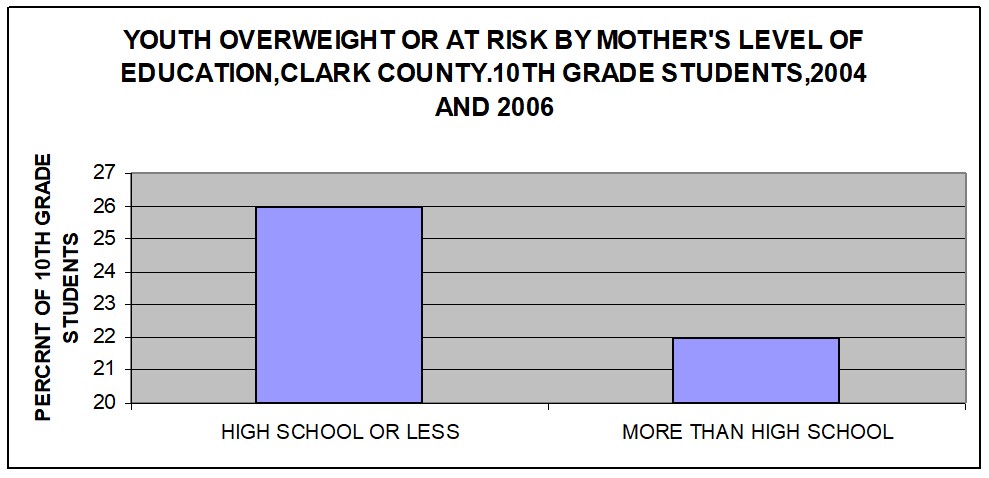Abstract
This research project investigates the public health challenge of obesity among youths in Clark County. Clark County has traditionally experienced high prevalence rates of obesity that are proportionally higher than other similar Counties among the youths. Currently, the County has a prevalence rate of obesity of 38% in adults and 25% among children. The overall objective of this research project was to tackle this challenge through careful investigation of obesity in youths to propose effective strategies that would combat and reverse the high incidence rate of obesity among this group. This involved collecting relevant data from three key areas: 200 cases, 100 parents, and a sample of 10 schools. The equipment that was used for this research included desktops, transport, weighing and height machine, and questionnaire forms. The research project found out that there is an alarming increase in the cases of obesity across the ages and especially among the youths of Clark County, Vancouver, Washington. The shift in the eating habits into refined food and soft drinks coupled with inadequate physical exercise has led to an increase in the cases of obesity among the youths of Clark County. To combat obesity, change in eating lifestyle and enhanced physical exercises among youths are highly necessary to prevent the dire consequences associated with obesity.
Introduction
Obesity is a medical complication that severely affects how the human body produces and uses insulin. Being overweight is a precursor to obesity. Both overweight and obesity are measured similarly both among adults and youths. For adults’ obesity and overweight are measured using an index called Body Mass Index (BMI). Body Mass Index is a ratio that relates a person’s weight and his or her height. Therefore a person is considered to be overweight if his or her Body Mass Index is between 25.0 and 29.9.similarly a person is considered to be obese if his or her Body Mass Index is over 30. For youths overweight and obesity are measured using standardized growth charts. The current global projections by the World Health Organization on the trend of obesity indicate that more than 3 billion people would be overweight by the year 2015 while childhood obesity is now considered the “most serious public health challenge of the 21st century” (WHO). The malady of obesity in the larger population is a real threat that no longer affects low-income families alone but is more increasingly occurring in middle-income families. This means that a significant proportion of people, especially children, are at risk of becoming obese. The WHO estimates that 42 million children who are under five years of age worldwide are obese, 90% of these children will remain obese in their adult life and will constantly be dogged by various conditions such as cardiovascular disease and high blood pressure which are normally triggered by the presence of obesity.
Over the past two decades, Obesity has emerged as a National health epidemic and a major cause of diseases such as type 2 diabetes, hypertension, and various heart diseases. The majority of Americans support plans to create programs that address the obesity crisis because of two important factors: First, there are 300,000 deaths annually in the U.S resulting from obesity complications and second, Close to $100 billion is spent annually on healthcare for obese adults. Such programs include expanding educational curriculums about healthy living and reduction of the marketing of unhealthy food. Also, exercise programs should be subsidized to enable all Americans to access these recreational facilities (Community Choices, 2006).
The root causes of the high prevalence rates of obesity among youths
in Clark County is due to two interrelated factors; lack of health education and lack of appropriate care by the parents. The parents, for instance, maybe regarded as too busy to check the dietary lifestyle of their children. The children have therefore developed poor eating habits. Clark County is also lacking in civic education necessary to help and enhance the eating habits of its people. This has brought a wave of detrimental results in terms of healthy eating in the county. Living a sedentary lifestyle is another significant factor related to increased cases of obesity in the county (Chaput, 3). Currently, few people living in the county are physically active. This has been caused by a large change towards less physically demanding work, increased use of mechanized transportation, and taking up less active recreational pursuits. In youths, there seems to be a reduction in the levels of physical activity. This has been caused by less walking, less physical education, and spending too much time watching television and/or on the computer.
It is on this basis that this research project was instigated to generate more knowledge on the subject of obesity which would enable effective interventions to be structured around the unique circumstances of youths with obesity conditions in this County. The results of this research project should provide an essential benchmark in determining the changes in healthcare policy pointing to the problem as well as healthcare reforms in Clark County.
Background Information
In an article appearing in Time magazine, the cost of obesity to the economy is estimated to be as much as “$73.1 billion as a result of an obese workforce” (Melnick). To a very large extent the highest proportion of adults with obesity are those who developed it when they were young which makes it paramount and crucial to address the issue of obesity in youths rather than in adults. This estimate does not even address all the associated costs that are incurred as a result of the condition; the most costly is the fact that obesity is considered a risk factor for several diseases that could easily be avoided by just losing weight. Indeed many research studies have identified a causal association between being overweight and conditions such as cardiovascular-related disease and diabetes
There is a high prevalence of obesity within Clark County compared to other regions in the U.S. It is on this background that different professionals at Clark County Public Health Department; Health Assessment and Evaluation Unit compiled and edited a report on Community health indicators. The report provided a snapshot of the health of the people within Clark County. The data in the report highlights some significant problems that are facing the County such as the increased prevalence of obesity, nutritional problems, and sedentary lifestyle. The findings in the report emphasize that obesity is a chronic medical condition that has severely affected the lives of the people living in the county. Therefore, concerted efforts should be made to suppress the spread of this epidemic. The data reveals that over the recent past, the prevalence rate of obesity among adults in Clark County has been increasing at an alarming rate; in 1996, 16% percent of adults were obese, a figure that has increased to 25% by 2006; this represents a 1% annual increase. Still, during this period the prevalence of overweight which is a precursor to obesity increased within the county at the rate of 38% in adults and 25% among children.
Besides this factor, the cost incurred by the government in addressing the issue of obesity has become daunting since it complicates the need to reduce the health allocation budgets. Finally, since many people who are overweight are generally not happy with their condition, reducing weight would have other benefits such as contributing to happy families and reducing stress levels.
Objectives
The objectives of this study were:
- Identify the extent of the problem of obesity and causal factors among the youths within Clark County.
- Identify effective interventions that could be implemented to address the problem of obesity in youths within Clark County.
- Analyze the weakness of the existing interventions that are currently used to address the problem of obesity in youths within Clark County.
Literature Review
Obesity refers to a medical condition whereby a person’s body structure is made up of excessive body fats to an extent that is detrimental to their health. More generally obesity and overweight are defined the same way as conditions where a person’s body fats are above normal levels. The official definition of WHO states that “obesity is a condition where a person has abnormal or excessive fat accumulation that may impair health” (WHO). The scientific approach of determining obesity in a person is the Body Mass Index (BMI); a ratio index that compares a person’s weight against their height to arrive at a numerical figure that is used to determine if a person is obese or not.
The WHO obesity framework categorizes and defines obesity and overweight differently; a person is defined as overweight if their BMI figure exceeds 24. Beyond 29, the official definition of the condition becomes obesity. Nevertheless, numerous research findings indicate that risk factors of diseases associated with obesity tend to significantly increase among persons that have a BMI of 31 and above. Generally, obesity is categorized into three groups: class I obesity, class II obesity, and class III obesity. Class, I obesity is for individuals within the range of 30-34 BMI, Class II obesity for persons between 35-40 while Class III is for persons with BMI figure that is above 40 and the most serious of all.
Causal Factors: Obesity
The major cause that is attributed to the high rate of obesity prevalence in the world today is mainly lifestyle changes. The term lifestyle when used in this context describes a particular way of living based on two forms of determinants; types of food eaten and physical activeness. Foods that are high in fats, sugar, and carbohydrates can easily cause obesity when taken in large quantities higher than the body requires for sustenance. High intake of foods rich in fats, carbohydrates, and sugars over some time consequently causes accumulation of energy that is stored in the form of fats within a person’s body leading to excessive weight. Excessive weight gain is the root cause of obesity.
Lack of exercise is not a cause of obesity per se; rather it is a confounding factor that accelerates the process of obesity, given that the body is not actively utilizing the excess energy that is stored in form of body fats. However recent research findings indicate that the cause of obesity, in that case, is hardly limited to the two factors mentioned above; obesity is now also determined to be influenced by a person’s genetic makeup, frequency of eating, rate of metabolism, medications, psychological factors and certain diseases, all of which varies among different people.
The frequency of eating has also been determined as another key causative factor for obesity notwithstanding the amount of food that a person consumes. Whereas this factor is not yet clearly understood, most research studies attribute the phenomenon to the metabolism process of cholesterol and insulin, which are the two major agents that determine the accumulation of fats in the body. It has been observed that when small meals are taken several times a day there are fewer insulin and cholesterol levels in the blood system compared to when only one large meal is taken. Thereby, verifying the significance of frequency of food intake to the outcome of obesity.
A closely related factor to the frequency of food intake pertains to the type of food eaten. This is perhaps the leading causative factor of obesity when all other conditions are equal. For instance, french fries when eaten regularly are known to significantly contribute to obesity; in addition, they adversely affect a person’s health in general. Carbonated soft drinks have also been linked to obesity due to their high sugar content. Most burgers, fried potatoes, doughnuts, hot dogs, and most baked foods are just examples of other food types that are associated with obesity due to their high cholesterol, carbohydrates, and sugar content.
The predisposition of a person to become overweight is also caused by genetic factors. This is because obesity is linked to the genetic makeup of an individual through leptin deficiency; this is a hormone that is essential in weight regulation that functions by signaling the brain when more calorie intake is required or vice versa. Hence, deficiency of leptin among obese persons is a documented common characteristic that makes them unable to control their food intake thereby leading to their obesity condition. Other factors that are known to contribute to weight gain are certain medications such as antidepressants, anti-convulsants including most diabetic medications which are known to induce weight gain through side effects.
Risk Factors
Many research studies indicate a strong causal association of obesity with several chronic and serious types of diseases notably obesity and cardiovascular diseases. Thus it is one of the major causes of death in the world. Obesity leads to increased chances of developing heart diseases, type 2 diabetes, certain types of cancer, as well as other health problems. The presence of obesity alone predisposes someone to an array of not less than ten disease conditions that range from cardiovascular diseases, high blood pressure to hypertension.
There are four broad categories of disease conditions that are directly linked to obese conditions: cardiovascular diseases, diabetes, musculoskeletal disorders, and specific types of cancers.
Methods and Materials
This research study was conducted on two levels:
- Primary research: primary research involved the collection of data through administering questionnaires from the three target groups; youths, parents, and teachers. Random sampling was employed in selecting cases from larger populations. A total of 200 cases, 100 parents, and 10 schools were interviewed.
- Secondary research: secondary research involved using computer application packages to analyze the data obtained in the primary research and comparing these results with the findings of previous research studies on the same subject.
Results and Discussion
According to statistical records of the year 2004-2006, about 10% of the County Clark youths are obese as compared to the 2010 goal of 5% by Health People. The obesity among students shows that male students have higher obesity levels than female students. Male students have an obesity level of 14% while female students have an obesity level of 6%. On the other hand, students whose mothers have education levels above high school showed a lower obesity level of 8% while students whose mothers have education levels below high school showed a higher obesity level of 12%.
The percentage of youths who are obese or at risk of obesity is about 25% and this again depends on the gender and socioeconomic factors of students. The major factors contributing to the rise in obesity cases are; inadequate dietary intake of fruits and vegetables, high intake of refined food and soft drinks, and inadequate physical exercise.
Obesity among youths is not only a health issue but also a social issue. Since obese youths are prone to develop other diseases like diabetes type II, heart disease, and hypertension and by extension affect their school performance.
Based on the statistical figures, the rate of increase in obesity cases among youths is quite alarming and requires immediate intervention. The shift in the eating habits into refined food and soft drinks coupled with inadequate physical exercise has led to an increase in the cases of obesity among the youths of Clark County. To combat obesity, change in eating lifestyle and enhanced physical exercises among youths are highly necessary to prevent the dire consequences associated with obesity.
Conclusion
Obesity is a serious public health problem in Clark County. The prevalence of this medical condition has been increasing sharply among youth in the county because of failure to observe healthy eating habits and as a result, the following proposed solutions should be urgently adopted by the various government and non-governmental agencies concerned with public health and be streamlined into policies.
This research found out that there are numerous fast-food restaurants and cafes by the roadside. These restaurants and cafes sell unhealthy foods that are rich in fats. To curb the increase in obesity prevalence within Clark County, then strategies should be put in place to drastically reduce the number of such restaurants and cafes while enhancing the establishment of groceries that sell highly nutritious fruits and vegetables at affordable prices. To achieve this food-pricing strategy can be adopted to encourage the purchase of nutritious foods by increasing prices of unhealthy foods while reducing the price of healthy foods.
Parents should make up more time for their children to ensure that they are eating healthy foods and are physically active (Kumanyika and Brownson, 349). Parents can encourage healthy eating habits for their children by cooking healthy food for them instead of giving them money to buy food from cafes and restaurants by the roadside. Parents can also ensure that their children are physically active by making up more time to play with them games like football and jogging or going out for picnics with them where they can engage in physical exercises together.
Youths spend most of their time in schools and colleges. School feeding programs should therefore be revised to ensure that the food being served at schools is highly nutritious. Meals served in schools should include foods like legumes, fruits, and vegetables. In this respect, the Food System Council of Clark County should advocate for youth programs in schools such as fruit and vegetable snacks and the expansion of school gardens to provide enough space for the youth to engage in physical exercises.
Clark County should adopt civic education programs aimed at improving the eating habits of its people. This may include an emphasis on calorie-controlled diets or low-fat diets and meals based on starchy or high-fiber carbohydrates. This can be done through a vigorous media campaign and community-based sensitization seminars and conferences.
Youths residing within Clark County should be encouraged to have dinner with their families as opposed to going to restaurants to have dinner with friends. Family dinner is usually healthier than dinner served in restaurants. Besides reducing obesity cases; family meals provide an opportunity for the youth to learn communication skills, good communication skills as well as reduce chances of substance abuse and depression (Community Choices, 2006).
Youth within Clark County should engage in various programs aimed at promoting lifestyle changes from the sedentary lifestyle. These programs should involve behavioral changes related to diet modification and increasing the amount of physical exercise (Dehghan, Akhtar-Danesh, and Merchant, 78).
Works Cited
Balentine, J. & Mathur, R. Obesity: Causes and Risk Factors, 2010.
Chaput, Jean-Philippe, et al. “Physical Activity Plays an Important Role in Body Weight Regulation.” Journal of obesity (2010): 1-11. Print.
Chen, H. Diseases and Conditions: Obesity, 2008. Web.
Clark County.com. “Community Assessment, Planning, and Evaluation: Quantitative Health Assessment Report” Clark County Public Health. April 2009. Web.
Dehghan, M., Akhtar-Danesh, Noori, and Merchant, Anwar T. “Childhood obesity, prevalence and prevention.” Nutrition Journal 7:2 (2006): 74-82. Print.
Kim S., Willis L., Talking About Obesity: News Framing of who is Responsible for Causing and Fixing the Problem. J Health Communic, 12.1 (2007): pp 359–376. Print
Kumanyika, Kinika S., and Brownson, Ross C. Handbook of obesity prevention: a resource for health professional. New York: Springer, 2007. Print.
Melnick, M. “Study: Obese Workers Cost Emplyers $73 Billion per Year”, Time Magazine. Web.
Mitchell, J., Padwal, R., Chuck, A. & Klarenbach, C. Cancer Screening among the Overweight and Obese in Canada. Am J Prev Med, 35.1 (200): pp 127–132. Print.
WHO.com. Obesity and Overweight: What are Obesity and Overweight?, 2010.
Appendix
In 2006, 3,296 Clark County youth aged 12- 17 were overweight.
The healthy people 2010 goal was that only about 5% of children and adolescence should be overweight. Both in 2004 and 2006, Clark County did not meet this goal because 10% of 10th grade students were overweight.
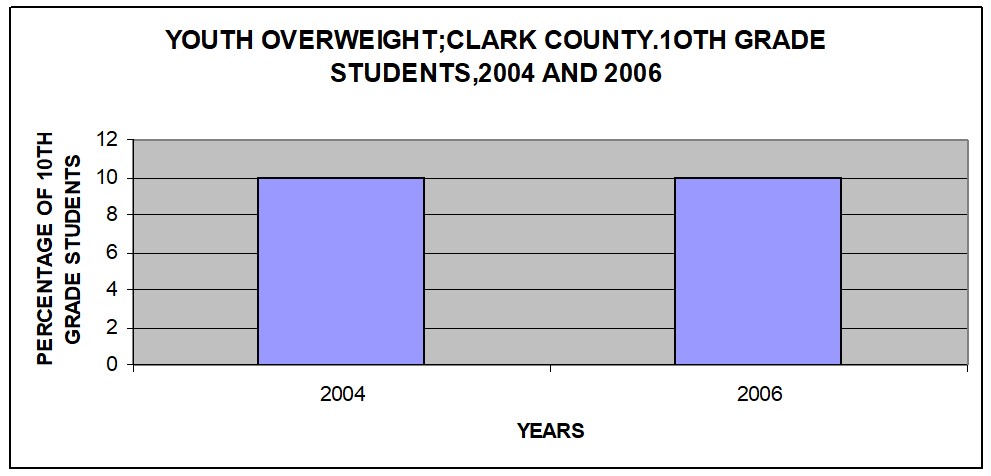
In 2004 and 2006 in Clark County, youth overweight among tenth grade females was lower than males.
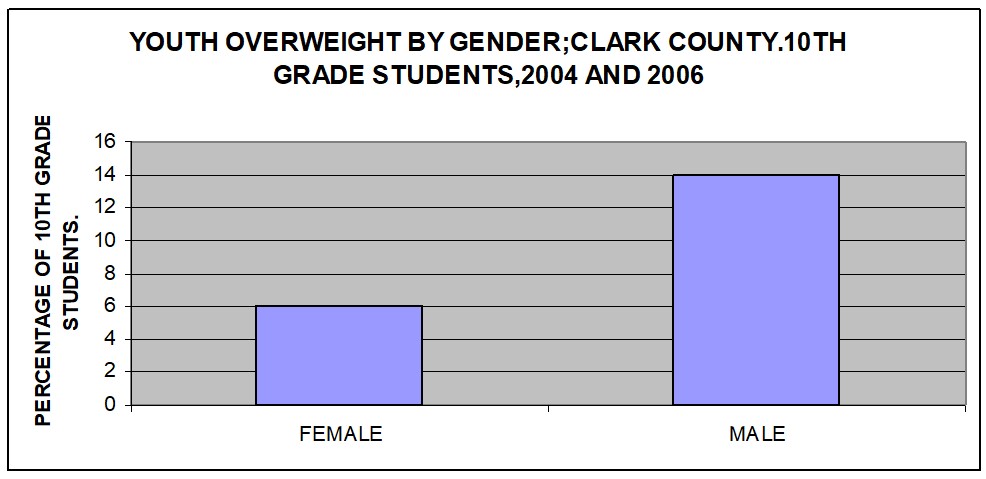
Youths whose mothers had educational levels only up to high school level had higher overweight cases compared to youths whose mothers had completed high school education and above. This is according to Clark County data for 2004 and 2006 among 10th grade students.
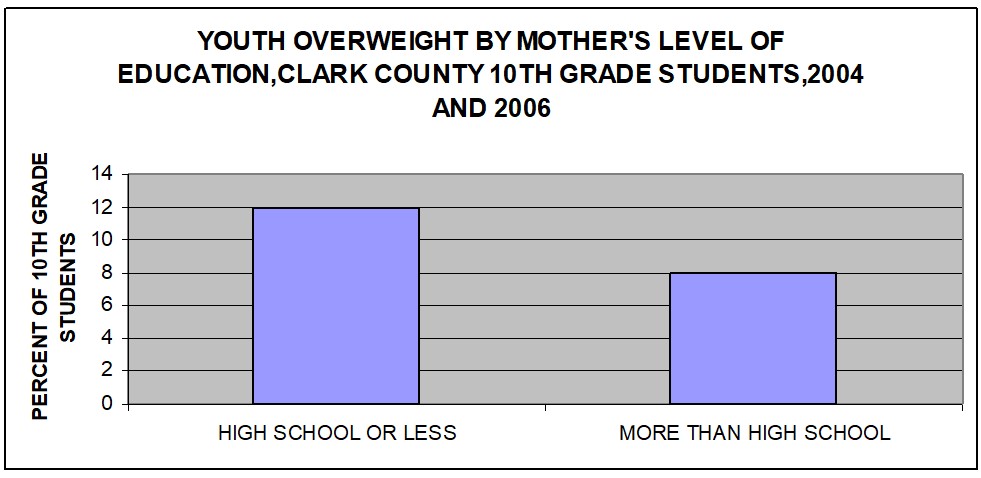
In 2004 and 2006 in Clark County, Youth overweight or at risk among tenth grade females was lower than males.
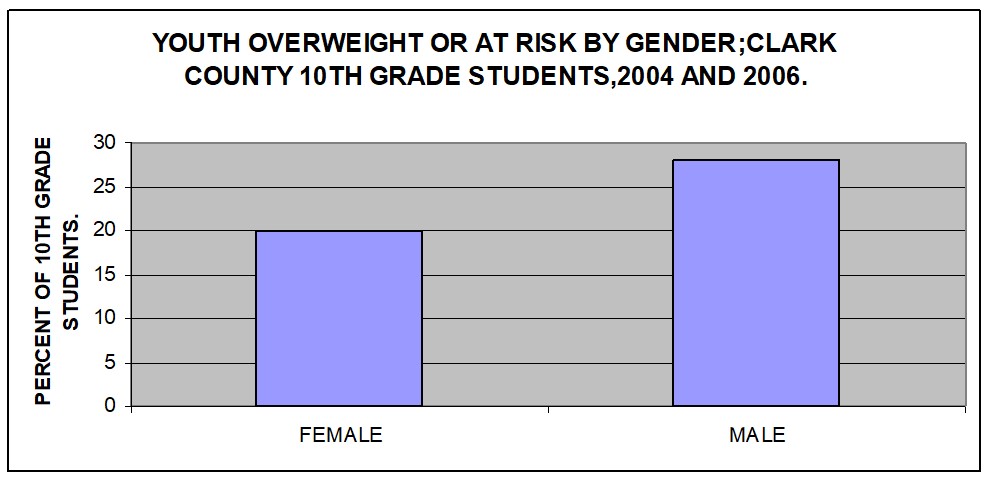
Youths whose mothers had educational levels only up to high school level had higher overweight cases or at higher risk compared to youths whose mothers had completed high school education and above. This is according to Clark County data for 2004 and 2006 among 10th grade students.
